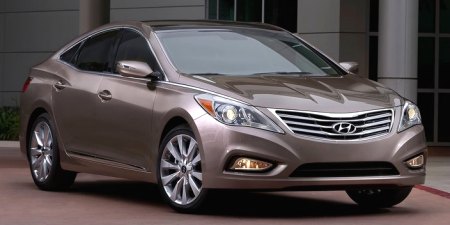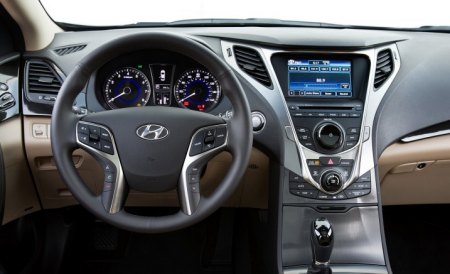Published
on 10
Apr 2012
|
All rights reserved.
|
|
|

Hyundai's
current design theme, Fluidic Sculpture, gets better and better since
its debut in the 2009 Sonata. The progress is evident on the latest
generation Azera (or Grandeur in Korea). This car looks sleeker,
sportier and sexier than a large executive saloon has any rights to be.
Look at its beautifully flowing lines and the sharp creases over the
rear shoulders, I would say this car is even more convincing than many
so-called "4-door coupes", such as Volkswagen Passat CC, to catch our
sense of aesthetics. Meanwhile, the exterior also shows high level of
coherence and finishing, without any odd / radical / flamboyant details
that could possibly fail the test of time. This proves that Hyundai has
really come to its own in terms of design. Hats off to its
internationalized design team.
Exterior design is certainly the trump card of the new Azera.
Comparatively, other areas are rather understated. Don't get me wrong,
the new car is not bad by any means. Far from it actually, it is much
more competitive than the car it replaces – faster, better built, more
refined and finally feels built in one solid piece rather than a
summation of
components. It no longer needs a throat-cutting price to lure buyers.
However, neither will we describe its driving dynamics, refinement and
build quality as class-leading. There are plenty of cars that drive
better and feel classier, such as BMW 5-series, Mercedes E-class,
Jaguar XF, Audi A6, Lexus GS and Infiniti M-series. The Hyundai can
only pursue to be the best of the rest. It targets the same audiences
as Lexus ES350, Toyota Avalon, Acura TL, Ford Taurus, Buick LaCrosse
and Chrysler
300. Its mainstream prices reflect that intent, as is the long list of
standard equipment. For the same money you will be struggling to find a
fully loaded
BMW
328i, let alone a European E-segment
executive saloon. In Hyundai's own family chart, the Azera sits under
Genesis.

Having known its market positioning, you won't be disappointed to see
the interior of Azera looks more like an upscale Sonata than a bespoke
luxury. Its dashboard design is a reminiscent of its smaller sister.
Instruments are conventional. Switch gears feel mass production. You
are surrounded by mostly soft plastics, supplemented with limited
leather trim but with no traces of real wood accents or solid metal
switch gears to make you
feel great. In other words, it lacks the smell of luxury. However,
space is plenty. Even though the coupe-style roof line looks low,
6-footers can sit at the rear with complete comfort.
The lower cost base is also evident from its underpinnings. The
front-drive architecture with all-steel suspensions consisting of
MacPherson struts up front and multi-link
rear axle is derived from Sonata. It also features the same Sachs ASD
mechanical adaptive dampers rather than a computer-controlled
system normally found on the premium players of this
segment. What distinguishes it from its sibling is engine: the Azera is
powered by a 3.3-liter GDI Lambda II V6 good for 294 horsepower and 255
pound-foot of torque. It is pretty advanced, with all-alloy
construction, direct injection, dual-VVT and a 3-stage variable intake
system, although green technologies like automatic stop-start,
on-demand
cooling/lubrication and regenerative braking are missing (note: the
only green feature is an Eco mode for the engine and transmission
mapping). Beside the 3.3-liter, Korean version Grandeur is also
available with a 270 hp 3.0-liter GDI V6 and a 201 hp 2.4 GDI
four-cylinder. As six-cylinder is no longer available to Sonata, some
buyers may move up to the Azera. A bit disappointing, all three engines
hook up to the Sonata's 6-speed automatic instead of the new 8-speeder
of Genesis and Equus, as the latter is not compatible to transverse
engines.

Owing to its relative simplicity, the Azera is quite light at 1635 kg.
In addition to close to 300 horsepower, its performance should be
sparkling. Unfortunately, its relatively small capacity – vs the class
norm of 3.5 liters naturally aspirated or 3 liters turbo/supercharged –
means the V6 is short of low down torque. The transmission's civilized
response does not help either. As a result, the car never feels as
potent as the figures suggested. It takes the high six seconds range to
accelerate from rest to 60 mph, trailing the premium class rivals by
about a second –
that feels a day-and-night difference in the real world.
On the positive side, both the V6 and gearbox run smoothly and quietly.
Though lacking firepower, they serve the duty of a comfort-oriented
executive car very well.
On highway, the Azera's vastly improved NVH suppression keeps noise
shut out of the cabin, ensuring its occupants to feel a high level of
refinement. The ride is smooth, too. However, at low speed, coarse
surfaces, the unsophisticated suspension could transmit more shocks and
noises into the cabin than a top-tier executive car should. This
reveals a setup firmer than the outgoing norm of Hyundai as well as the
current Lexus ES350. On the flip side, body control is decent, if not
sporty. The car turns into corners quite responsively for a
front-driver. Its electrical power steering is more consistently
weighted than that of the Sonata, although it still feels artificial.
The brake pedal is nicely modulated. Overall, its chassis is one of the
better controlled among the second division players of E-segment,
although it
is not as refined as some rivals. Just don't expect it to match the
best rear-drive or all-wheel-drive premium rivals. If Genesis cannot do
that, let alone Azera.
That's why its exterior design is somewhat misleading.
|
Verdict:    |
|